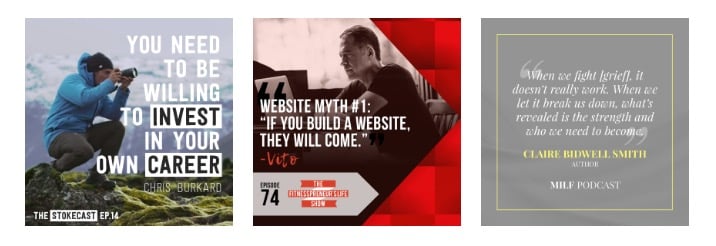In recent studies, 44 percent of marketers claimed that content production is one of their top challenges. And we get it. It takes a ton of time, resources and editing to create new content. Time that most entrepreneurs don’t have excess of when they’re busy starting and maintaining a new business.
But, you know that the content you create is valuable, both to your audience and to your business. Too often, we spend so many hours creating new content to push out to our website, email list and social media that we lose sight of the goldmine of content we already have.
That’s why repurposing your existing content is crucial. This allows you to turn just one piece of content (i.e. a blog article, your book, video or podcast episode) into many different micro-marketing assets that can then be shared all over social media.
Since you’re repurposing, you’ll find that you get to spend less time creating new content, and that you actually drive more traffic to your lead magnets (because you’re sharing way more with your micro-marketing assets). Another major benefit: you’ll also have more time to dedicate to nurturing the other aspects of your business.
Where to begin? Let’s get started.
Step 1: Choose the best clips of your long-form content
Take a look at your blogs, podcast episodes, videos, etc. and pull the best of the best.
If it’s a video or podcast episode, stick to 2 minutes or less (if you want to put this repurposed section on Instagram, stick to 1 minute).
If it’s a blog or book, pull sections that are 100 words max.
These sections and clips should be clickbait worthy. Stats are great, as are snippets that provoke emotion and controversial sections. Gather as many sections as you want, and keep in mind that one 15 minute video may have six to seven smaller, 1 minute to 2 minute clips worth revamping.
Once you have those sections pulled, let’s start repurposing.
Related: 5 Simple Ways to Repurpose Your Blog Content
Step 2: Create the micro-marketing assets
Now that you have your impactful sections chosen, repurpose them into image quotes, video memes, audiograms, thumbnails, and so on.
Image Quotes
It’s best to cap these at 25 words max. Again, keep in mind that you’re not creating these words from scratch, they already exist. You’re just utilizing this content in new ways.
So whether it’s something you said in a video, wrote in a blog, or recorded on audio, take those words and put them on a beautifully designed images like the examples shown below. Great tools to create these include Canva (this is free!), PicMonkey and Photoshop.

Video Memes/Audiograms
If you have an audio-only podcast, a great way to turn a clip of your episode into a high-performing, repurposed micro-marketing asset it to turn it into video. That’s where audiograms come in. These are static images with an overlay of a moving waveform, subtitles and your voice. The top free tool to make these is Headliner.app, and they have a great tutorial on how to create such videos here. You can add the subtitles using the app, too!
On the other hand, if you have videos from speaking engagements, recorded webinars, how-to tutorials, etc., those are also great to repurpose. Turn them into shorter video clips (you can clip them with free tools like iMovie) and then again use Headliner.app to create the meme itself with subtitles.
Text-Motion Video
Now, how do you repurpose your startup’s blog or book content into more micro-marketing assets besides creating image quotes? You take those 100 max word sections and create a text-motion video.
Viewers retain 95 percent of a message when they watch it in a video compared to 10 percent when reading the same information via text.
So, this repurpose tactic is huge for for engagement and driving traffic to your full-length content. We prefer a tool called wave.video to create text-motion videos, but Headliner.app also allows you to do this for free.
Step 3: Optimize to drive traffic
Once you know which repurposed assets you’ll create for your existing, long-form content, make sure those pieces are optimized so that they drive traffic to your lead magnets.
Here’s your checklist:
- Put a CTA (call to action) on them when you can. For example, in one of the corners of your video, put the website URL you want them to go to. Example: “Learn More: ReallyCoolBook.com”
- Tell people where they can find you or your brand. It’s great to put @YourBusinessHandle on any of the repurposed pieces you create so your customers can find you via social media.
- Include subtitles on video memes and audiograms. Statistically, 80 percent more people are likely to watch a video all the way through if it has transcriptions.
- Write snappy copy that entices customers to learn more. This includes an image quote, headings on your video snippets, etc. Whatever your user is reading should make them want to click to learn more.
- Make sure your repurposed assets are in all the right sizes for where you’re posting them. We suggest square images for social media feeds like Instagram, and landscape images for YouTube. If you use a tool like Canva for design, they already have all of those sizes formatted!
Sign Up: Receive the StartupNation newsletter!
Step 4: Share them everywhere
Now that you have all of these image quotes, video memes, audiograms and text-motion videos repurposed and ready to go, it’s time to push them out! Below are a few platforms in which you can share your evergreen content:
- Facebook Stories
- Instagram Stories
- IGTV
- YouTube
- Snapchat
- Email marketing campaigns
While there’s a short learning curve for the tools listed above, this evergreen content strategy ensures that everything you create (videos, books, blogs, podcasts and more) truly gets shared the way your valuable content deserves.
Always remember that while content is king, distribution is queen, and your end goal is to provide value while driving more traffic!






